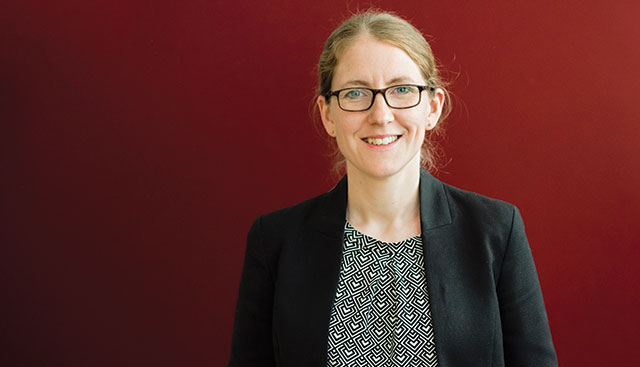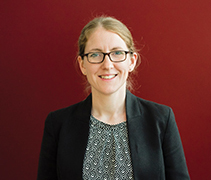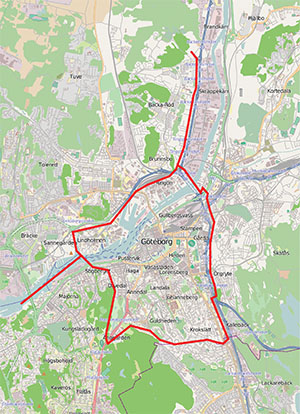The impact of congestion charges

KTH Royal Institute of Technology’s Ida Kristoffersson assesses the impact of the introduction of Sweden’s second congestion charge system in Gothenburg.
 Sweden has congestion charging systems operating in two of its largest cities, Stockholm and Gothenburg. The system was first introduced in Stockholm in 2006 where a large proportion of commuters now use the fast and reliable subway system. The charge proved a success in Stockholm and in 2013 officials in Gothenburg introduced a similar charging system in their city.
Sweden has congestion charging systems operating in two of its largest cities, Stockholm and Gothenburg. The system was first introduced in Stockholm in 2006 where a large proportion of commuters now use the fast and reliable subway system. The charge proved a success in Stockholm and in 2013 officials in Gothenburg introduced a similar charging system in their city.
“Policy makers in Gothenburg wanted to copy the success of Stockholm’s system. They initially wanted to implement Stockholm’s congestion charge in Gothenburg, but Stockholm, thanks to its layout and topography lends itself to a charging system, Gothenburg is different,” KTH Royal Institute of Technology’s Ida Kristoffersson states. Stockholm is home to 2.2 million inhabitants and is built on 14 islands, with charge stations established on the bridges that connect the islands. Gothenburg is home to one million inhabitants and is a freight hub with only a few crossings over a river.
While the congestion charge points introduced at Stockholm’s bridges were an obvious solution Gothenburg had many different options available to it. In an effort to stop commuters using minor roads to avoid the charge, Gothenburg introduced 38 charging points as opposed to Stockholm’s 18. Both systems have been planned with the commuter in mind and their only variation is the cost of entry to the charge zone depending on the time of day.
When the system was first introduced in Gothenburg it cost eight Swedish Krona (87 cents) to enter the congestion zone at 6am, by 7am this charge had increased to 18 Swedish Krona (€1.96). In 2015 the charge increased to nine Swedish Krona (98 cents) at 6am and 22 Swedish Krona (€2.40) by 7am. This increase in price has done little to further decrease congestion. “Moving from a zero cost system to one that charges has a much bigger impact than increasing the charge by a couple of Swedish Krona even though the increase in price has led to a 22 per cent increase in revenue,” states Kristoffersson.
Kristoffersson states that the primary motivation of the Gothenburg congestion charge is to increase revenue. However she also highlights the fact that Swedish law dictates that charging zones, if not introduced on a bridge or tunnel, have to be designed to reduce congestion.
Impact
The statistics gathered by Kristoffersson and her team suggest the congestion charge zone is having a positive impact on Gothenburg. During charge hours, traffic flow within the charge zone has been reduced by 12 per cent. Outside of charge hours there has been no notable change to traffic flow.
The introduction of the charge has had little impact on commuter’s departure time choice. While commuters may claim they are flexible in regards to their departure time the evidence presented by Kristoffersson would suggest otherwise. “When looking at citizen movement it is apparent that for many commuters there are too many restrictions on departure time. From our observations we can see that off-peak trips are more elastic,” states Kristoffersson. “It is easier to change recreational trips than work trips and the pattern present in Gothenburg is very similar to the one observed in Stockholm.” While it is clear commuters have transitioned to public transport thanks to the introduction of this congestion charge, discretionary trips have changed in other ways. Kristoffersson regards this variation in adaption strategies as an advantage of the system as it allows people to come up with their own solutions.
The evidence suggests that commuters have transitioned to public transport. However, Kristoffersson is unsure of the overall effect the introduction of the congestion charge has had on the use of public transport. “It has been difficult to obtain data on travel habits as citizens of Gothenburg don’t have to tap their travel cards to use public transport,” says Kristoffersson. “We have witnessed ticket sales increase by 7.5 per cent but this has been growing by about 2 per cent per year for many years so we estimate that there has been a 5 per cent increase in the adoption of public transport as a direct consequence of the congestion charge.”
 While it appears that many have adapted to the introduction of this charge, public approval of the system is low. While there is political support for the system, Kristoffersson explains that in a consultative vote in 2014, 57 per cent of citizens voted against the system. “This vote caused problems for the authorities,” states Kristoffersson. “They were forced to conduct studies assessing alternative methods to reduce congestion but no other alternative was found and as such, they pressed ahead with the system.” Despite this display of discontent Kristoffersson notes that in 2006 there was also notable dissatisfaction in Stockholm with only 53 per cent of the city’s citizens in favour of the system. However, a recent survey suggests that 75 per cent of Stockholm citizens now approve of the system.
While it appears that many have adapted to the introduction of this charge, public approval of the system is low. While there is political support for the system, Kristoffersson explains that in a consultative vote in 2014, 57 per cent of citizens voted against the system. “This vote caused problems for the authorities,” states Kristoffersson. “They were forced to conduct studies assessing alternative methods to reduce congestion but no other alternative was found and as such, they pressed ahead with the system.” Despite this display of discontent Kristoffersson notes that in 2006 there was also notable dissatisfaction in Stockholm with only 53 per cent of the city’s citizens in favour of the system. However, a recent survey suggests that 75 per cent of Stockholm citizens now approve of the system.
Focusing on other benefits of the system, Kristoffersson highlights a 5 per cent improvement in air quality in the inner city as a direct result of the system and explains that while the socio-economic benefits of the system are not as great as in Stockholm, they are still present. “The size, density and congestion levels in Gothenburg are at the lower limit for charging to be socio-economically beneficial but while the benefit exists it is worth pursuing,” she states. Reflecting on the impact of detours by car users determined to avoid the charges, Kristoffersson acknowledges an increase in the use of minor roads but suggests that as the increase was smaller than expected, the roads have the capacity to cope with the increase in demand.
Ultimately, the introduction of congestion charges in Gothenburg have had a substantial effect with commuters transitioning to public transport and discretionary trips adapting in other ways. There have also been notable reductions in air pollution levels, a small decrease in travel time and the cost benefit analysis of the system has highlighted its socio-economic benefits. “Even though the systems are different we have witnessed similar adaption patterns in both Stockholm and Gothenburg,” says Kristoffersson. “There are many benefits to the introduction of congestion charges and while initial public perception may not be favourable, following its introduction the public ultimately accept and appreciate the benefits that the charge system offers.”





